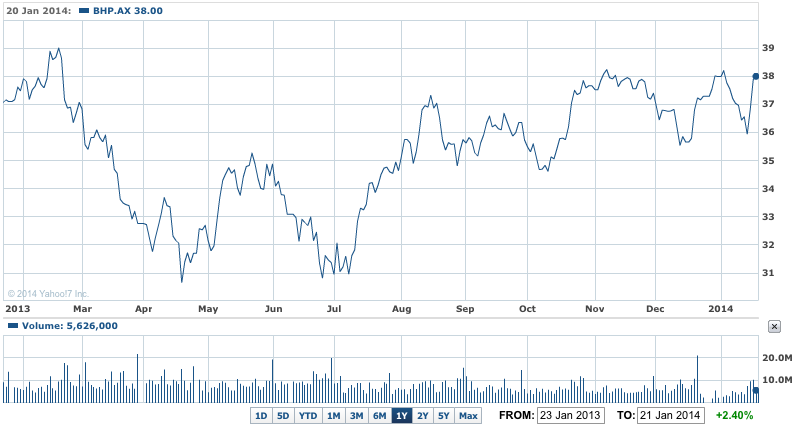So with investors here and offshore in a sour mood about China, commodities and emerging markets, it’s no wonder that the continuing weakness in iron ore prices made for a difficult day for BHP Billiton (BHP) yesterday after it reported its December quarter and half year production figures.
According to many brokers, BHP fell short of expectations – not its expectations, but those optimistic figurings from various analysts in banks and brokers.
In fact the reaction was different to the generally favourable reception for Rio Tinto’s (RIO) 4th quarter and full year report last Friday.
But not helping sentiment, unlike a year ago, global iron ore prices have started the year weaker – they are down around 8.2% at $US124 a tonne so far this month having fallen well below the $US130 a tonne level they maintained for much of 2013.
The two big miners ended the day down around around 1% each at $37.56 (BHP) and $65.15 (RIO).
BHP had said in its report that it remains on track to achieve full year production guidance in its four main commodities – coal, iron ore, petroleum and copper.
BHP said that that its Pilbara iron ore network produced 53.6 million tonnes of iron ore in the December quarter. That made 108 million tonnes in the first half, meaning the company is ahead of schedule on its promise to produce 212 million tonnes from its Pilbara mines in the year to June 30.
BHP had raised its forecasts for annual iron-ore production in October, thanks to improvements to its supply chain, as well as the earlier-than-scheduled start of production at the new Jimblebar mine. That remains the forecast going into the final six months of 2013-14. ( Rio Tinto unveiled production and shipment records for its flagship iron ore business, with both up 5% in 2013 from 2012 and is looking to boost output and sales in 2014.)
The petroleum division went close to meeting expectations, producing 57.7 million barrels of oil equivalent across the broad suite of oil and gas products. Total petroleum production for the December 2013 half year was 120.4 million barrels of oil equivalent.
The Queensland coking coal business also responded strongly to the opening of the new Daunia mine, achieving record production. Output of coking coal rose 30% to 11.5 million tonnes in the quarter. Thermal coal output dropped 5% to 17.8 million tonnes, BHP said. Coking coal production rose 22% in the December half to a record 22 million tonnes.
Copper production for the quarter rose 6% to 439,900 tonnes from higher production at the Escondida mine in Chile. For the full six months copper output was also up 6% at 843,000 tonnes.
But production at BHP’s Olympic Dam operation will be affected by a 20-day planned smelter maintenance shutdown this half, it said. That means production during the current financial year will be in line with 2012-13, BHP said.
Alumina production rose 8% to a record 2.6 million tonnes.
BHP 1Y – BHP provides an okay December update

BHP Billiton Chief Executive Officer Andrew Mackenzie said in yesterday’s statement, “Strong operating performance across our diversified portfolio in the December 2013 half year delivered a 10 per cent increase in production and volumes are expected to grow by 16 per cent over the two years to the end of the 2015 financial year. Iron ore and metallurgical coal were particularly strong and are very well positioned to achieve guidance, notwithstanding the general uncertainty that exists as we enter the wet season.
“Our productivity continues to improve and this was most clearly demonstrated by our Queensland Coal business which ran at an annualised rate of 68 million tonnes in the December 2013 quarter. Our productivity agenda is in full swing and we expect to carry strong momentum into the second half of the financial year.
“During the period, six of our major projects delivered first production and our 10 remaining projects, which are largely low risk, brownfield expansions, are tracking to plan. By maintaining strict financial discipline and increasing internal competition for capital we intend to further differentiate ourselves by achieving a superior rate of return on incremental investment. We also remain committed to actively managing our portfolio for value. This strategy leaves us well positioned to deliver a substantial increase in free cash flow and higher returns to shareholders.”
BHP said its share of capital and exploration expenditure for the 2014 financial year remains around US$16.1 billion as planned. That should please those picky analysts.
It did, judging how many comments from analysts overnight focused on that and downplayed the production records.













